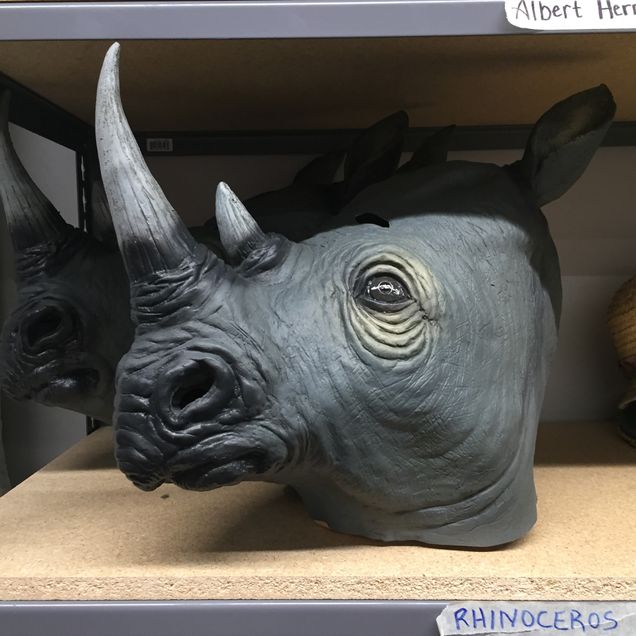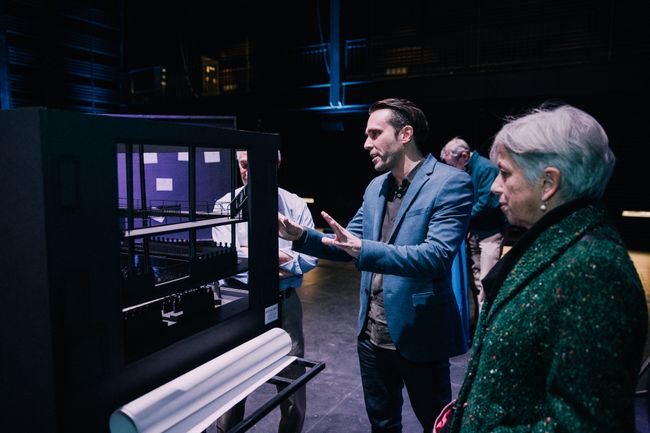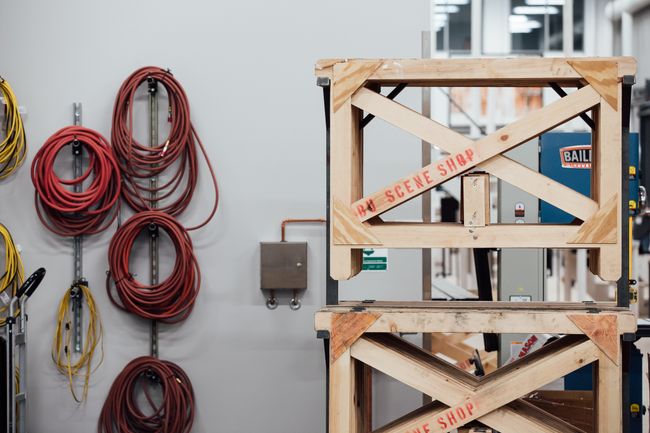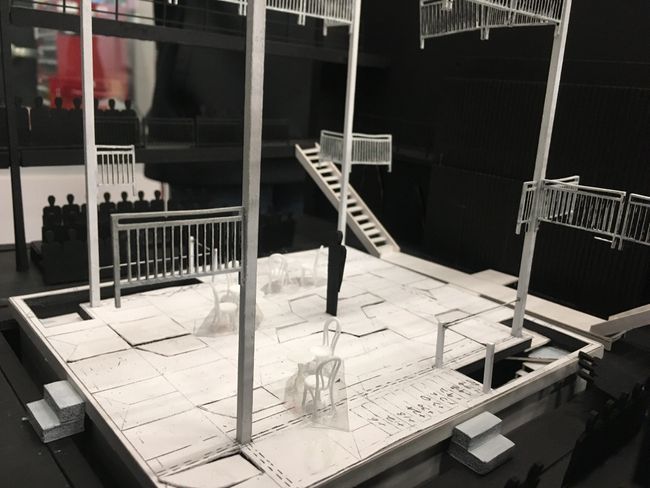D+P at BU
Rhinoceros comes alive in new Design & Production Center for Booth Theatre’s first production.
Spark Volume 3, Issue 3 | by Emily White
Infinite possibilities face the production teams working in the new theatre on Commonwealth Avenue… well, maybe not infinite, but pretty close. The Boston University Joan & Edgar Booth Theatre and College of Fine Arts Production Center are the latest transformations propelling CFA into its next phase. With the design and production component in close proximity to the performance space, Clay Hopper, director of the first play in Booth, was ready to take on the daunting challenge of making the most of this new versatile venue.

Stomping onto the stage for a groundbreaking unveiling of the new theatre is a crash of rhinoceroses. Literally. These beasts usher in a new era for CFA and the School of Theatre—one in which Design & Production and Performance teams collaborated for the first time in the University’s innovative arts space. The first production in Booth, which ran in February, is Eugène Ionesco’s absurdist commentary Rhinoceros.
In this savage and ridiculous observation on the human condition, a staple of 20th century drama, a small town is besieged by one roaring citizen who literally becomes a rhinoceros, and proceeds to trample on the social order. As more citizens are transformed into rhinoceroses, the trampling becomes overwhelming, and more and more citizens become rhinoceroses. One sane man remains unable to change his form and identity.

“The reason why I’m so excited about this as the first play in the space is that you’d be hard-pressed to find a show that is timelier,” according to Hopper. Ionesco wrote this play as an absurdist allegory after the second World War and a response to the rise of fascism. “It excavates the dynamic that allows people and cultures to normalize these absurd things…which is so appropriate now in this insidious, post-fact media environment.”
The latest in a poignantly curated and politically charged season exploring the darker side of the human condition, in which the banality of evil seeps undetected in society and in ourselves, has challenged audiences to grapple with the notion that morality is tenuous if not cultivated. Summer Orientation brought new students scenes of a moral man slowly turned to the Nazi party in Good, and Cabaret’s wry critique of the rise of fascism in Germany slinked into Studio 102 in December. This spring’s Rhinoceros similarly takes on this gradual becoming, as despite all reason, one by one the townspeople transform into rhinoceroses. Antigone will close the season at Booth with an exploration of war, oppression, and family.

As Theatre Arts major and Arts Leadership minor Shawna M. James (CFA’18) sees it, for audience and performer alike, “the importance in this piece lies in the resonance with today’s socio-political climate…. While this play is deeply funny and absurd at moments, it cuts like a knife. I don’t think people will have a hard time connecting the dots between its relevance to our modern society. For me, as a performer, this play is important because it is an opportunity to explore deeply how we make sure history does not repeat itself.”
James recalls the “distinct separation between our two theatre spaces” when she joined the School of Theatre. Now, with all of the School’s performance and design spaces housed on Commonwealth Avenue, she and her classmates “have the ability to collaborate quickly and share information.” To her, Booth Theatre and the adjoining D&P Center is a “University-wide statement of acknowledgement that the arts matter.”
“It’s been exciting to see the evolution of this great new innovative space… and the synthesis of two separate cultures into one,” says Hopper. Not confined to a specific orientation regarding audience or performance, the design and production teams dwell in possibility. The audience can experience productions in the round, or from endless configurations of seating risers in the 21,000 square foot theatre, or watch the cast perform sixteen feet below their feet. As Hopper explains, “we really can shape the space in any way we can imagine.”
While the actors in this production faced the challenge of metamorphosing into two-ton beasts on stage, the crew embraced the experiments of the new space, from sets to lighting. “The theatre is one that demands excellence and lots of play,” says James. “I am most looking forward to the lighting grid. Normally, theaters have a singular grid that stays in place but our theater actually has nine individual grids that can be operated separately or together. They can fly in and out of the space expanding the opportunities to create really cool multidimensional worlds, unlike anything I have ever experienced. I think Rhinoceros will do a wonderful job of showcasing the potential this space has.”

27,000 feet of production and support facilities and 60 studio stations inhabit the footprint of 820 Comm Ave, bringing set builders, costume designers, lighting and sound experts, and technical teams to the back door of the stage. Scene Shop Manager Todd Burgun joined the Design & Production team as the building came to life in the fall of 2017. In addition to overseeing the function and efficiency of the scene shop space and equipment, Burgun supervises crews for productions and mentors the student technical directors in developing and managing construction and running crews for various theatrical endeavors.
Jumping into Booth and the D&P Center in such an early phase was exciting for Burgun, who began building out the shop with custom work spaces, stationary tools, and storage. Soon, the shop started to take on life. “It was extremely sensational watching the building grow. There are some breathtaking spaces in this building. The glass façade on the front of the building looks amazing from the outside. But, when you are inside the lobby looking out, the large scale of this hits you and is stunning.”
Booth Theatre and the D&P space will further enhance the experience of the students, designers, and builders who will utilize the space. “This building allows, more than ever, for these students a place for gathering and collaboration,” says Burgun.
The Rhinoceros production team aimed to showcase Booth through the show’s design, meanwhile dealing with the challenges of bringing the unique show into the unchartered waters of this new facility.

Paul Dufresne (CFA’19) studies Scene Design for theatre and opera and is responsible for creating the physical world of the production, from the scenic elements to the shifts and movement throughout the show. “It has been a dream to be able to see the new theatre come together. For so long we were working in a space that had limitations when it came to the production and design center. There are still challenges and great opportunities with this space. What a wonderful gift the theatre community at Boston University has been given with Booth Theatre!”
Dufresne sees the new space as overflowing with potential. He’s excited to put his skills to the test on crafting a production involving automation and various stage mechanisms. “Designing the first show in any new space is an important and exciting opportunity that has allowed me as a designer and us as the School of Theatre, to present our new space to the Boston University community in the greater community of Boston.” The new facility “challenges us to look at this work of theatre in a new way. The new theatre is a flexible space that has dramatic potential inherent in its intelligent construction. It allows us to create a space for the play to take place within.”
“The impact that this space will have on this institution cannot be overstated,” claims Hopper. “I’m honored to be a part of opening it. This new facility will become a hub for our community beyond the walls of CFA.”